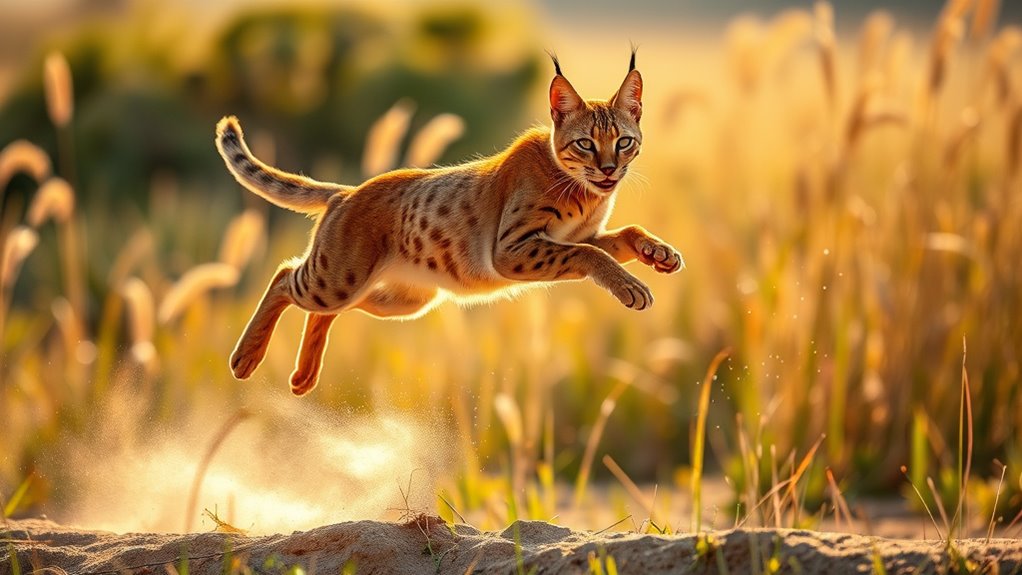The caracal is an incredible feline known for its impressive jumping skills and agility. With powerful hind legs, it can leap up to 10 feet high and effortlessly snatch birds mid-air. These solitary cats primarily hunt at dawn and dusk, using stealth and sharp eyesight to stalk small mammals. Their striking appearance, marked by tufted ears and sleek tawny fur, showcases their wild beauty. There’s so much more to discover about their unique traits and behaviors!
Key Takeaways
- Caracals are known for their incredible agility, capable of leaping up to 10 feet high to catch prey.
- Their powerful hind legs allow them to cover significant ground in a single jump, making them exceptional hunters.
- This species primarily hunts small mammals and birds using stealth and precise timing to strike.
- Caracals are solitary and mainly nocturnal, showcasing their independence and adaptability in diverse habitats.
- Their striking appearance, with tufted ears and sleek tawny fur, emphasizes their unique beauty and skill as hunters.

Have you ever seen a cat leap with the grace and power of a caracal? If you have, you’ll know that these stunning felines are more than just beautiful. Their incredible agility and jumping ability make them one of the most impressive cats in the wild. With long legs and a muscular build, caracals can leap up to ten feet high, effortlessly snatching birds right out of the air. This remarkable skill sets them apart from other cats and highlights their unique behavior traits.
Caracals are known for their striking appearance, characterized by their tufted ears and sleek, tawny fur. You might find them in various habitats across Africa, the Middle East, and Central Asia. Their habitat range includes savannas, semi-deserts, and even scrublands, showcasing their adaptability. This versatility allows them to thrive in diverse environments, but it’s their behavior traits that truly make them fascinating. Unlike many other cats, caracals are mainly nocturnal, meaning they come alive at dusk and dawn. This lifestyle not only aids in hunting but also helps them avoid larger predators.
Caracals, with their tufted ears and tawny fur, thrive in diverse habitats, showcasing their adaptability and fascinating nocturnal behavior.
You’ll notice that caracals are solitary animals, preferring to roam alone rather than in packs. This independence plays a vital role in their hunting strategy. They rely on stealth and speed, using their sharp eyesight to spot potential prey from a distance. When they do decide to pounce, their powerful hind legs propel them into the air, allowing them to cover significant ground in a single leap. It’s a breathtaking sight that demonstrates their mastery of the hunt.
Their diet consists mainly of small mammals and birds, which they capture with precision. The caracal’s ability to leap high and swiftly makes it an effective predator. When you observe them, you can see how their behavior traits, such as patience and calculation, come into play during the hunt. They stalk their prey with a quiet confidence, often waiting for the perfect moment to strike. Additionally, caracals’ solitary nature mirrors the emotional availability challenges faced in many workaholic relationship dynamics, highlighting the importance of balancing independence and connection.
Frequently Asked Questions
What Does a Caracal’s Diet Primarily Consist Of?
A caracal’s diet primarily consists of small to medium-sized mammals and birds. You’ll find that their hunting habits are impressive, as they can leap high to catch prey. They often target rodents, hares, and various birds, showcasing their agility and stealth. If you’re observing a caracal, notice how it stalks and pounces with precision. Their diet reflects their adaptability to different environments, making them skilled hunters in the wild.
Are Caracals Solitary or Social Animals?
Caracals are solitary souls, roaming the wild like whispers in the wind. Their territorial behavior is fierce, marking their domains with confidence and asserting their presence. When it comes to mating, they’re not the social butterflies you might expect; instead, they engage in fleeting encounters, driven by instinct rather than companionship. In this dance of nature, you see their independence shine, reminding you that solitude can be both powerful and beautiful.
How Do Caracals Communicate With Each Other?
Caracals communicate using a mix of vocal communication and visual signals. You’ll notice them making a range of sounds, from growls to purrs, to convey different messages. Their body language also plays a key role; they use ear positioning and tail movements to express feelings or intentions. By paying attention to these cues, you’ll gain insight into their social interactions and behaviors, helping you understand how they connect with each other.
What Is the Lifespan of a Caracal in the Wild?
In the wild, a caracal’s lifespan typically ranges from 12 to 15 years. However, many face threats in their habitats, making conservation efforts vital. As you explore their world, remember that preserving their environment helps guarantee they thrive. Without these efforts, their numbers could dwindle, and you might witness a fading beauty. So, stay informed and support caracal conservation initiatives to protect their habitat and secure a future for these majestic animals.
Can Caracals Be Kept as Pets?
Caracals can be kept as pets, but it’s essential to check local legal considerations first. Not all places allow ownership of exotic animals, so make sure you’re compliant. If you decide to adopt one, you’ll need to invest in proper caracal care tips, including spacious enclosures, a specialized diet, and plenty of mental stimulation. Remember, they’re wild animals at heart, requiring more than just food and shelter to thrive in a home environment.
Conclusion
In summary, the caracal’s incredible jumping ability showcases its adaptability and hunting prowess. Imagine spotting a caracal leaping effortlessly over a 3-meter-high fence to catch a bird in mid-flight. This agility not only highlights its physical skills but also demonstrates how well it’s adapted to its environment. By understanding the caracal’s unique traits, you can appreciate the intricate balance of nature and the remarkable abilities that wild animals possess in the pursuit of survival.










